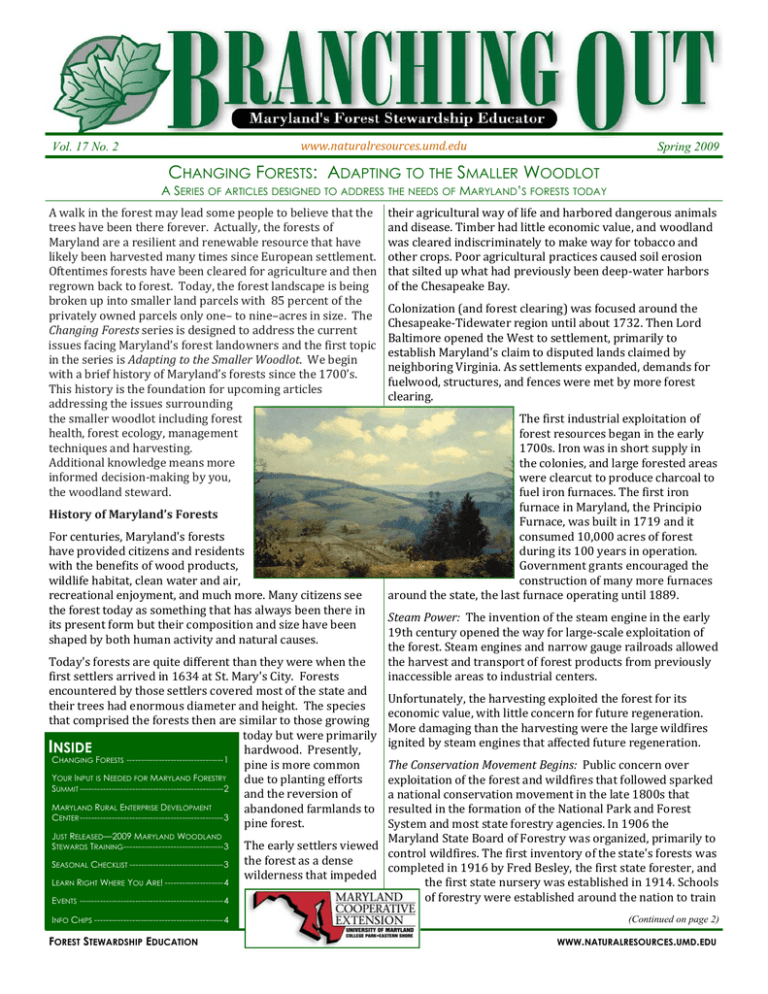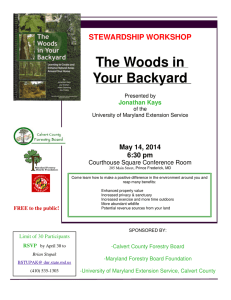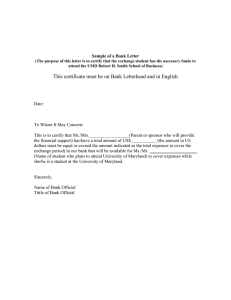Vol. 17 No. 2 Spring 2009 www.naturalresources.umd.edu A walk in the forest may lead some people to believe that the
advertisement

www.naturalresources.umd.edu Vol. 17 No. 2 Spring 2009 CHANGING FORESTS: ADAPTING TO THE SMALLER WOODLOT A SERIES OF ARTICLES DESIGNED TO ADDRESS THE NEEDS OF MARYLAND’S FORESTS TODAY A walk in the forest may lead some people to believe that the trees have been there forever. Actually, the forests of Maryland are a resilient and renewable resource that have likely been harvested many times since European settlement. Oftentimes forests have been cleared for agriculture and then regrown back to forest. Today, the forest landscape is being broken up into smaller land parcels with 85 percent of the privately owned parcels only one– to nine–acres in size. The Changing Forests series is designed to address the current issues facing Maryland’s forest landowners and the first topic in the series is Adapting to the Smaller Woodlot. We begin with a brief history of Maryland’s forests since the 1700’s. This history is the foundation for upcoming articles addressing the issues surrounding the smaller woodlot including forest health, forest ecology, management techniques and harvesting. Additional knowledge means more informed decision‐making by you, the woodland steward. History of Maryland’s Forests For centuries, Maryland's forests have provided citizens and residents with the benefits of wood products, wildlife habitat, clean water and air, recreational enjoyment, and much more. Many citizens see the forest today as something that has always been there in its present form but their composition and size have been shaped by both human activity and natural causes. Today's forests are quite different than they were when the first settlers arrived in 1634 at St. Mary's City. Forests encountered by those settlers covered most of the state and their trees had enormous diameter and height. The species that comprised the forests then are similar to those growing today but were primarily INSIDE hardwood. Presently, CHANGING FORESTS --------------------------------- 1 pine is more common YOUR INPUT IS NEEDED FOR MARYLAND FORESTRY due to planting efforts SUMMIT ------------------------------------------------- 2 and the reversion of MARYLAND RURAL ENTERPRISE DEVELOPMENT abandoned farmlands to CENTER ------------------------------------------------- 3 pine forest. their agricultural way of life and harbored dangerous animals and disease. Timber had little economic value, and woodland was cleared indiscriminately to make way for tobacco and other crops. Poor agricultural practices caused soil erosion that silted up what had previously been deep‐water harbors of the Chesapeake Bay. Colonization (and forest clearing) was focused around the Chesapeake‐Tidewater region until about 1732. Then Lord Baltimore opened the West to settlement, primarily to establish Maryland's claim to disputed lands claimed by neighboring Virginia. As settlements expanded, demands for fuelwood, structures, and fences were met by more forest clearing. The first industrial exploitation of forest resources began in the early 1700s. Iron was in short supply in the colonies, and large forested areas were clearcut to produce charcoal to fuel iron furnaces. The first iron furnace in Maryland, the Principio Furnace, was built in 1719 and it consumed 10,000 acres of forest during its 100 years in operation. Government grants encouraged the construction of many more furnaces around the state, the last furnace operating until 1889. Steam Power: The invention of the steam engine in the early 19th century opened the way for large‐scale exploitation of the forest. Steam engines and narrow gauge railroads allowed the harvest and transport of forest products from previously inaccessible areas to industrial centers. Unfortunately, the harvesting exploited the forest for its economic value, with little concern for future regeneration. More damaging than the harvesting were the large wildfires ignited by steam engines that affected future regeneration. EVENTS ------------------------------------------------- 4 The Conservation Movement Begins: Public concern over exploitation of the forest and wildfires that followed sparked a national conservation movement in the late 1800s that resulted in the formation of the National Park and Forest System and most state forestry agencies. In 1906 the Maryland State Board of Forestry was organized, primarily to The early settlers viewed control wildfires. The first inventory of the state's forests was the forest as a dense completed in 1916 by Fred Besley, the first state forester, and wilderness that impeded the first state nursery was established in 1914. Schools of forestry were established around the nation to train INFO CHIPS -------------------------------------------- 4 (Continued on page 2) JUST RELEASED—2009 MARYLAND WOODLAND STEWARDS TRAINING---------------------------------- 3 SEASONAL CHECKLIST -------------------------------- 3 LEARN RIGHT WHERE YOU ARE! -------------------- 4 FOREST STEWARDSHIP EDUCATION WWW.NATURALRESOURCES.UMD.EDU STEWARDSHIP EDUCATION Private woodland owners need current resources to make informed decisions that affect the future of their woodland, foresters and sponsor research whether it is large or small. We hope you follow Adapting to on how the forest could be the Smaller Woodlot, which continues in our summer edition managed to ensure adequate of Branching Out. regeneration and meet other Changing Woodland Series: needs of a growing nation. Adapting to the Smaller Woodlot Forest management services Some Upcoming Topics were first offered to Maryland Changes in the ownership of private forests woodland owners in the Forest inventory & health assessment 1950s. Ecological impacts —forest, water and wildlife (Continued from page 1) Clearing for agriculture reached its peak in the mid 1800s. Various episodes of land abandonment occurred after the Civil War and the Depression, with many fields reverting to pine and hardwood forest. By the early 1900s, most of Maryland's forests were cutover and just beginning to re‐grow. Many of our present‐ day forests were established from this and agricultural abandonment and regrowth . Today’s Challenges: Our present‐day forests are bearing the pressure of population expansion and resulting development. There have been great strides taken to preserve and conserve Maryland’s forests. However, the parcelization or subdividing of the landscape into smaller pieces continues. Forest stewardship planning Management techniques Protecting small woodlands from development Changes in harvesting equipment Sustainable Forestry Act of 2009 The Maryland legislature just passed the Sustainable For‐ estry Act of 2009. The Act establishes in law a framework for declaring and building upon the quantifiable benefits of sustainably managing privately and publicly owned forests. A more thorough analysis will be provided in the next issue. A copy of Senate Bill 549 can be found at: http://mlis.state.md.us/2009rs/bills/sb/sb0549t.pdf YOUR INPUT IS NEEDED FOR MARYLAND FORESTRY SUMMIT Change is affecting every aspect of forests. Many forest landowners in Maryland are struggling to plan for the future of their family lands in the face of reduced timber values and increased regulation. But with change comes opportu‐ nity. New markets for sustainable forest products and envi‐ ronmental services offer new opportunities for landowners, as citizens statewide begin to recognize the public values of private forests. It will take smart and inclusive planning, strategic public and private investment, and leadership at all levels to prepare Maryland’s landowners, communities, forestry professionals, and forest industry to succeed and thrive in this new world, and your input is important! Regional Listening Sessions will play a direct role in setting public policy that will affect your future. What kinds of technical support, educational opportunities, and cost share programs do you need to help you manage your forest land and market forest products in a changing world? Local and state leaders are faced with tough choices over how to spend scarce resources, and needs to hear from you. The listening sessions are tailored to give you the opportunity to express your concerns and needs. All listening session will be held at 6:00 p.m. at the locations to the right. For further information, contact: Ms. Nancy Nunn Coordinator, Development Harry R. Hughes Center for Agro‐Ecology, Inc. Phone: 410‐827‐8056, ext. 128/ nnunn@umd.edu or visit the Center's website: www.agroecol.umd.edu June 8 Baltimore, Harford and Cecil Counties Harford Community College (Room E132) 401 Thomas Run Road Bel Air, MD 21015 June 10 Caroline, Dorchester, Kent, Queen Anne’s, Somerset, Talbot, Wicomico and Worcester Counties Ramada Inn and Conference Center (soon to be Holiday Inn) 300 South Salisbury Boulevard Salisbury, MD 21801 June 15 Anne Arundel, Calvert, Prince George and St. Mary’s Counties College of Southern Maryland (Building BI, Room 113) 8730 Mitchell Road LaPlata, MD 20646 June 16 Carroll, Frederick, Howard, Montgomery and Washington Counties Urbana Regional Library (Urbana Community Room) 9020 Amelung Street Frederick, MD 21704 June 17 Allegany, Garrett and Washington Counties Frostburg State University (Compton 226) 101 Braddock Road Frostburg, MD 21532 PAGE 2 STEWARDSHIP EDUCATION NEW WEBSITE MAKES UNIVERSITY OF MARYLAND THE PLACE TO GO FOR INFORMATION ON RURAL AND COMMUNITY DEVELOPMENT The Maryland Rural Enterprise Develop‐ ment Center (MREDC) is now the place for the agricultural and natural re‐ sources community to go for valuable information thanks to the creation of a new website: www.mredc.umd.edu. The website was formally introduced at the Maryland Ag Commission meeting on February 11. mission report to the Governor. Specifi‐ Extension faculty to expand their pro‐ cally, MREDC’s mission is to: gramming resources. “Our hope is that our faculty will contribute their exper‐ 1. Serve as a portal for educational and tise, publicize events, post interactive outreach resources in marketing and presentations, and otherwise use this business development planning; website to assist their clients with such issues as entrepreneurship, business 2. Assist entrepreneurs in agriculture and natural resources enterprises in development, alternative enterprises, developing new marketing plans and and intergenerational transfer of busi‐ nesses,” says regional Extension market‐ opportunities; ing specialist Ginger Myers. 3. Serve as a launching pad to a wide variety of SEASONAL CHECKLIST web‐based university, community, and profes‐ Check trails and roads for erosion sional resources for Clean out culverts developing profitable, sustainable businesses; Check tree shelters to be sure they 4. Provide new and next‐ generation farmers with access to training, men‐ toring and business de‐ velopment resources; and 5. Provide continuing education and network‐ ing opportunities for agri‐ cultural support agency personnel, Extension staff, and agricultural eco‐ nomic development specialists state‐ wide. MREDC was established by the Univer‐ sity of Maryland College of Agriculture and Natural Resources (AGNR) to serve these communities through program‐ ming and support. The need for such an The website contains podcasts, video effort was identified through a series of presentations, webinars and other re‐ statewide listening sessions and docu‐ sources, including regional contacts and mented in a Maryland Agriculture Com‐ supporting agencies that will enable Branching Out University of Maryland Cooperative Extension 18330 Keedysville Road Keedysville, MD 21756-1104 | 301-432-2767 Editors: Jonathan Kays, Nevin Dawson, Ellen Green and Denni Johnson Published four times a year and distributed to forest landowners, resource professionals, and others interested in forest stewardship. Subscribe: To be notified by email when new issues become available, email (listserv@listserv.umd.edu). In the body of the message, type SUB branchingout your name (ex: SUB branchingout John Doe). For a hardcopy subscription, mail check or money order for $10 per year, payable to University of Maryland to the address above. Issues are posted online and can be downloaded for free: www.naturalresources.umd.edu. Send news items to Nevin Dawson at ndawson@umd.edu or 410-827-8056 x125. are properly in place Cut firewood for the next heating season Watch for invasive shrubs Plant trees Check last year's plantings for excess competition and control with spray or mowing if necessary Check for snow and ice damage Enjoy spring! Just released! The next Maryland Woodland Stewards training is scheduled for September 17—20, 2009. To apply or nominate someone else for this program, please contact Nevin Dawson by email (ndawson@umd.edu) or by phone (410-827-8056 x125). Learn more by visiting: http://www.naturalresources.umd.edu/ EducationalMWS.html September 17—20 Camp Pecometh Centreville, MD Equal Opportunity Programs PAGE 3 IN EVERY ISSUE USEFUL RESOURCES AND EVENTS LEARN RIGHT WHERE YOU ARE! DISTANCE LEARNING OPPORTUNITIES Whether or not you use the internet, you’ve probably heard terms such as e‐ learning, correspondence course, webinars, podcasts, etc. What is all this referring to? We like to call it Distance Learning—learning right where you are. No commute, no classrooms, sometimes free of charge, and no chances of being late! In this issue of Branching Out, we’ve included many distance learning opportunities we think are valuable (and some of these opportunities don’t necessarily require a computer). So...Happy learning—right where you are! Master Logger____________________ The Maryland/Delaware Master Logger program offers four core courses by using pre‐recorded Adobe Connect webinars. You can use a high speed internet connection to access the Adobe Connect webinars over the internet, or view offline using a CD‐ROM that is mailed to you. In either case, there is a video component included on DVD also mailed directly to you. For more information about Master Logger courses, contact the program coordinator, Nevin Dawson (ndawson@umd.edu). Enterprise Development ___________ NRAES Resources__________________ http://www.mdforest.umd.edu. Like to read? The Natural Resources, Agriculture and Engineering Service (NRAES) publishes many manuals and practical guides for self‐directed learning. There are many categories of books including Natural Resources and Forestry and Home and Garden. NRAES is located in Ithaca, NY, and coordinates the publishing efforts for 11 land grant universities including the University of ForestConnect____________________ 5/13/09 2:00 p.m. EST Climate Change Continuing Education Webinar Series, Spring Semester 2009: Introduction to the “Climate Wizard,” a web‐based tool for local cli‐ mate change forecasting. More information online at: http://www.nrs.fs.fed.us/carbon/webcasts/ 5/13/09 5/14/09 Licensed Tree Expert Training: Offered by the Maryland Department of Natural Resources Forest Service for anyone who is seeking to take the Maryland Tree Expert exam to become a Maryland Licensed Tree Expert. For more information, call the Forest Service at 410‐260‐8531 or visit: http://www.dnr.state.md.us/Forests/programapps/LTEClass.pdf 5/27/09 5/29/09 Forest Landowners Association, Inc. Annual Conference: Amelia Island, FL. More information online at: http://www.forestlandowners.com/content/annual­conference 9/17/09 9/20/09 General Forestry Course___________ http://www.mredc.umd.edu/ rootdistance.html EVENT 7/19/09 7/25/09 http://www.nraes.org/ The University of Maryland Cooperative Extension will offer the General Forestry Course for the fall 2009 semester. Both the paper and online version will be offered. The course begins September 1 and runs until December 15, 2009. Registration opens August 1. The cost is $300.00. To learn more and to register, call or email Nancy Stewart—410-8278056, ext. 112, nstewar1@umd.edu. Learn more by visiting: Find online podcasts, videos and pre‐ recorded webinars on the Distance Learning page at Maryland Cooperative Extension’s latest resource, the Maryland Rural Enterprise Development Center (MREDC). See the complete article about MREDC on page three of this newsletter. DATE/TIME June 2009 Maryland Cooperative Extension. Visit NRAES online at: ForestConnect Forestry Internet Seminar Series is provided by Cornell University Cooperative Extension. Each seminar provides unbiased, research‐based information to forest owners and all who are interested in private forestland management. See upcoming events and access recorded events at: http://www.dnr.cornell.edu/ext/ forestconnect/web.htm Webinar Portal____________________ The Southern Forestry and Natural Resources Webinar Portal, a service of the Southern Regional Extension Forestry Office, North Carolina State University's Extension Forest Resources, Texas A&M AgriLife Extension, and other participating land-grant universities in the South, serves as a launching point for current and archived natural resource webinars. http://www.forestrywebinars.com INFO CHIPS Listening Sessions in preparation for Maryland Forestry Summit. See details POSTED BY MARYLAND DNR: Dry Conditions Elevate Fire Danger. and schedule on page 2. ATTENTION HIGH SCHOOL STUDENTS! Natural Resources Careers Conference: Hickory Environment Education Center, Garrett County, Maryland. More information online at: http://www.dnr.state.md.us/forests/ nrcareersconf.html Debris Burning Leading Cause of Maryland Wildfires. Read complete press release at: http://dnr.maryland.gov/dnrnews/ pressrelease2009/032309b.html 2009 Maryland Woodland Steward Training: Camp Pecometh, Centreville, MD. To register, contact Nevin Dawson by email (ndawson@umd.edu) or by UNIVERSITY OF MARYLAND COOPERATIVE EXTENSION phone (410‐827‐8056 x125). www.naturalresources.umd.edu http://www.naturalresources.umd.edu/EducationalMWS.html PAGE 4



